Imagine: you wake up on Sunday morning in a hundred-year-old wooden house, awakened by gentle sunlight. Soon after, you hear the church bells located nearby, across the road, and the commotion of Panemunė’s residents rushing to Mass. Slowly you go to the old wood-burning stove to make some scrambled eggs watching the slender pines through the window and then you go down to your workshop to fix the precious grandmother’s chair that requires renewal.
In a few years, such slow and romantic evenings will become a reality in a creative house K.I.N.A.S. Panemunė. But while waiting for the future it makes more sense to live in the present. The activities of Panemunė creative house are already in full swing, the visitors are invited to events and workshops. I met with Giedrius Bučas, the soul and nurturer of this creative house, public activist, change leader. During the conversation that turned into a tour, we were accompanied by the master of the house, a cat named Cat.
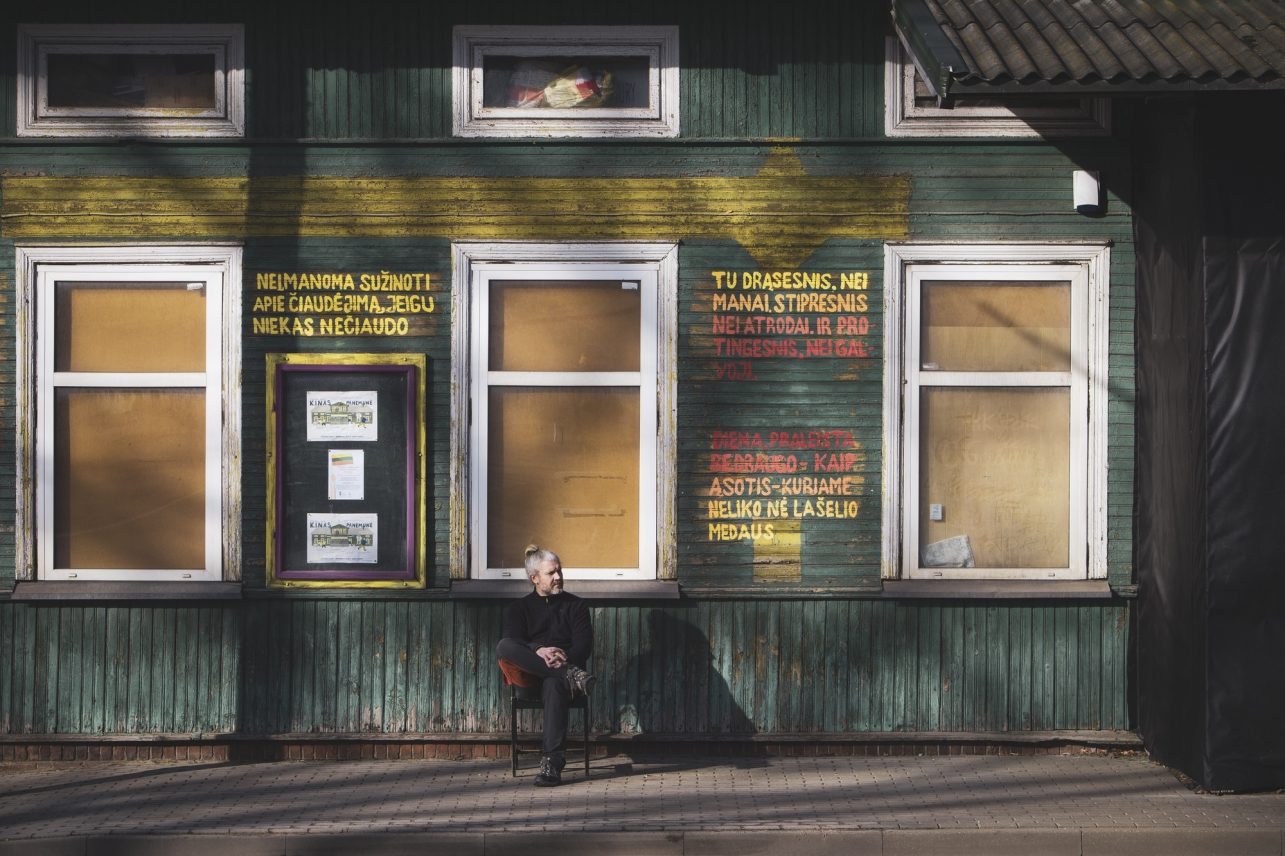
This beautiful wooden house with a mezzanine was built in 1930. It is a rather big house with two ends, typical of the interwar period wooden architecture, located in Panemunė on Vaidoto St. 26. This old house, having changed its purpose and owners several times, has recently been reborn with a new quality as Creative House K.I.N.A.S. Panemunė. We enter the building through the annex. The ground floor has a lobby, a main hall with a stage, a workshop space, a bathroom and an exit to the courtyard. On the second floor, along the corridor, are four rooms and an attic. The different sizes are surprising: upon entering, you feel very small due to the large space, but in the two rooms on the second floor, you feel like a giant because the ceiling is only two meters high.
Immediately after the building was built, and throughout the interwar period, it served as a school, where the children were taught by the sisters of St. Casimir and the second floor was dedicated to a kindergarten. During the Soviet period, the purpose of the building had changed. Cinema Panemunė opened its doors there and after some time a library was set up. After the restoration of independence, the library branch continued to work in the house and part of it was dedicated to Panemunė community. Giedrius reminds us that the building also housed a funeral home, Caritas, and on the second floor there was an office of the director of the cultural centre and two apartments.
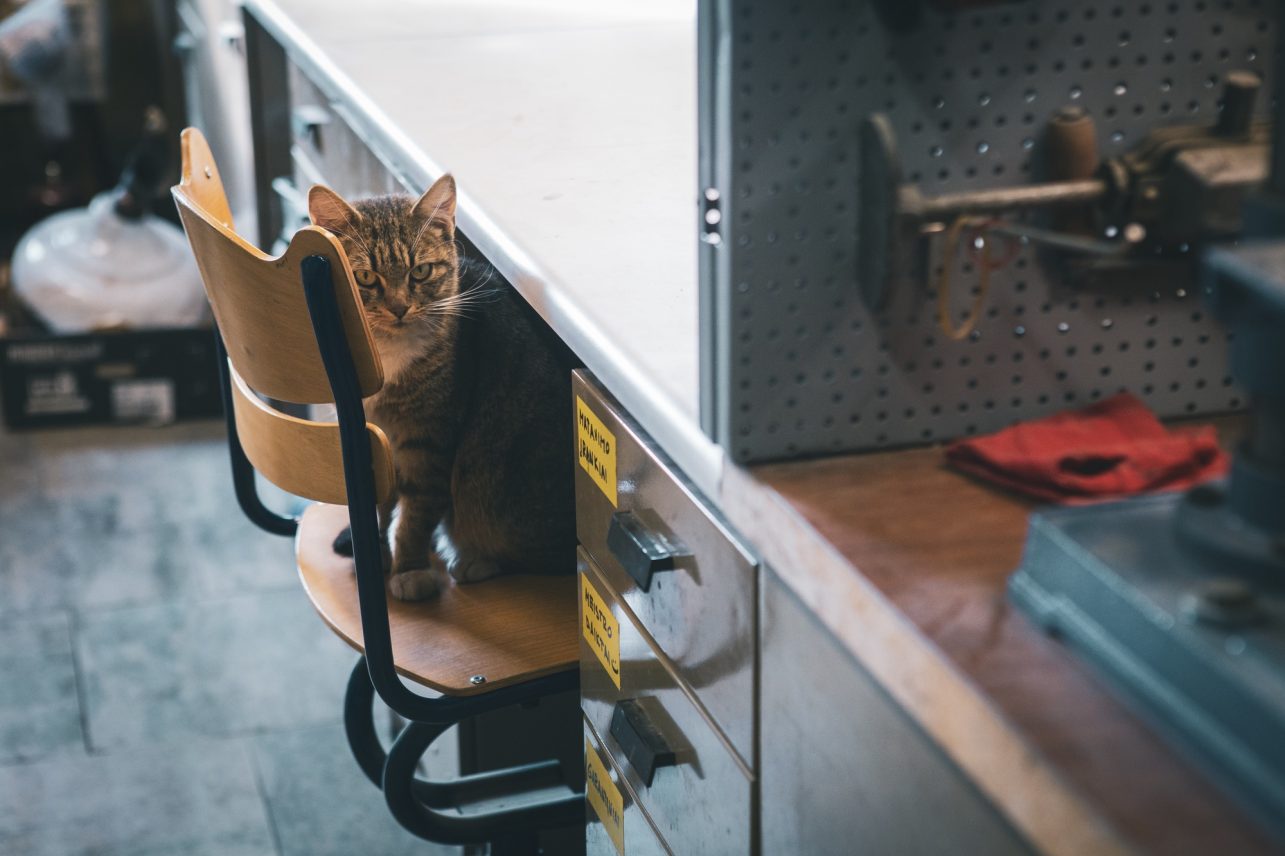
Different periods have left their own marks on the house. In the main space of the building, the ceiling is 4 meters high, and there is also a stage. Giedrius says that during the interwar period this space served as classrooms and during events it was vacated. During the Soviet period, an annex appeared. It served as an entrance to the Cinema Panemunė (hence the name of the current creative house K.I.N.A.S. Panemunė). In the annex, you can still find a surviving ticket office, that floods many visitors with memories. The house also has its own secrets. It is not clear what the original facade looked like, what the balcony was like, or what was the colour of the house. “I want to turn back time and collect all the information about the building’s history. Of course, it doesn’t end, but also repeats itself: the films will be shown again in the hall.”
When asked about the uniqueness of the house, Giedrius admits that creative house became very dear to him very fast. “Interesting things happened here, functions changed, and thus countless stories and people are connected to the house. It is rather unique: one acted on the stage, another watched the films resting on these wooden chairs, yet another sold tickets to the films. Someone studied in this room, borrowed books from the library or lived on the second floor. It was a public building, that was being visited a lot. I am glad that we will continue to work in the same direction.”
Interesting and strange items can be found in the building, which had many owners. Files and inventory lists left on the second floor, as well as the calendar of 1996 and a landline in the office point to the work of Caritas. There is a cassock hanging on the wall and in the next room there are many pink paintings as well as painting depicting saints. One of the strangest finds – now posing phantasmagorically with a rose in a workshop space – is a several decades-old mummy of a rat. “When we started cleaning up the house, we also began to write about our activities and work and people shared their memories. One man said that as a child he visited a movie theatre here, remembering a cold room and a barely warm stove. The children jokingly threw a dead rat into a hole behind it. While tidying up we found the little mummified rat and this story was substantiated.”
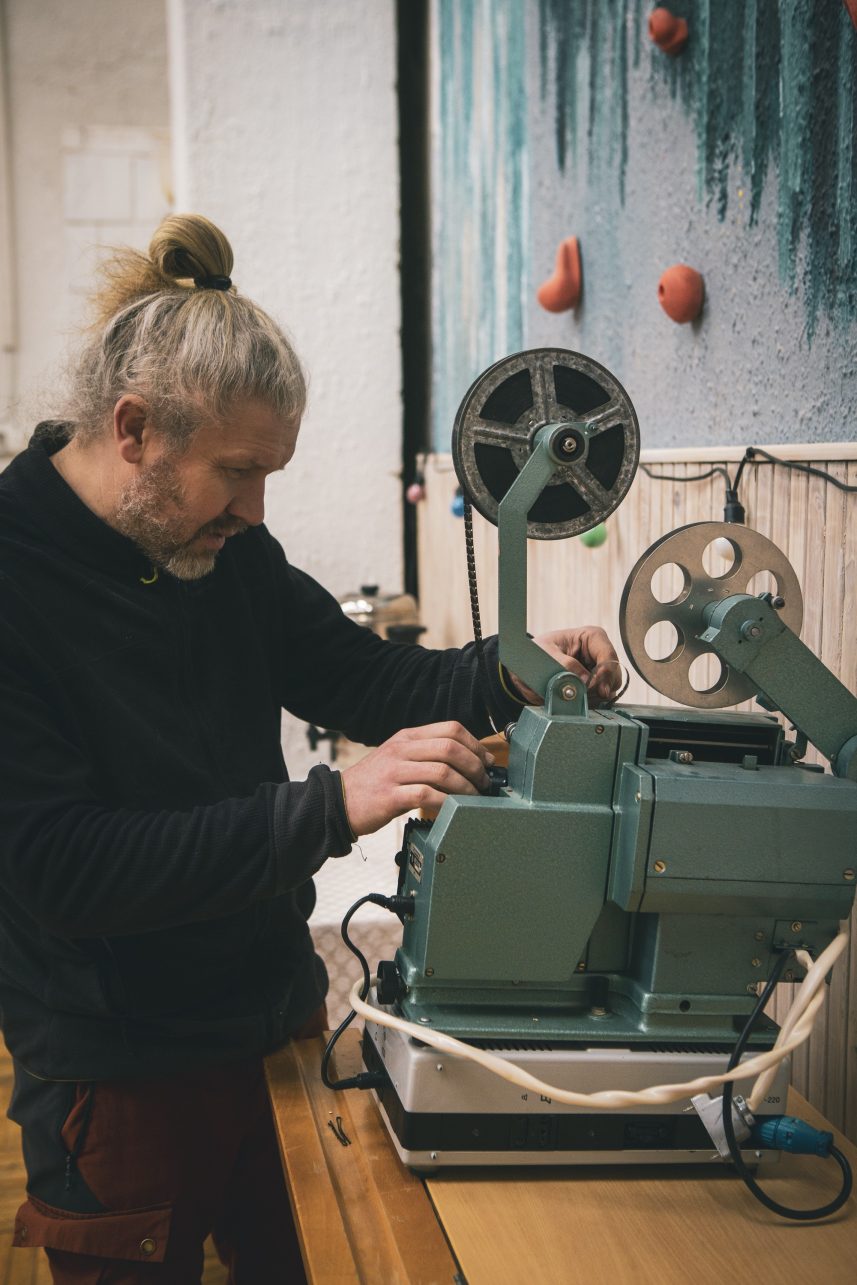

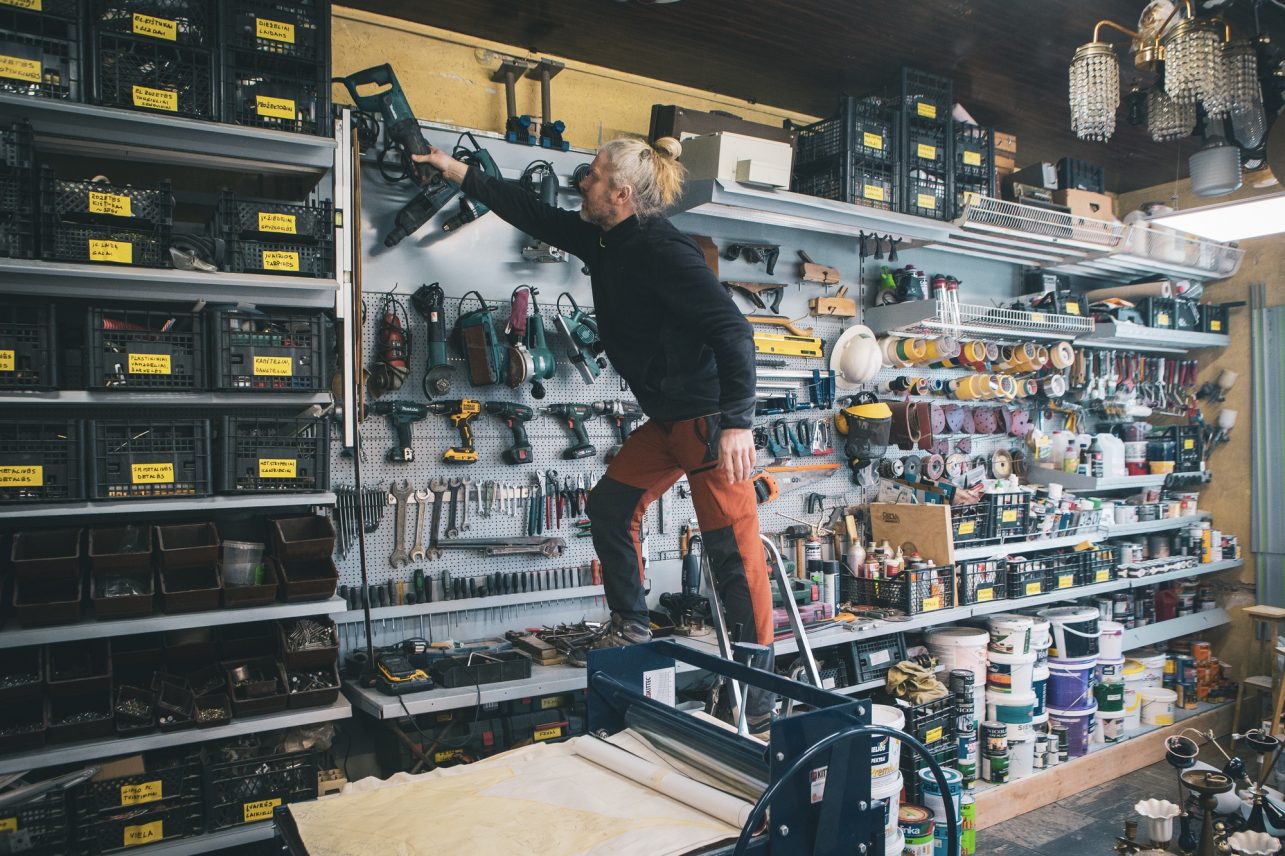
There will be no shortage of new visitors’ pranks because the wooden house is open to the public again. How did this synergy between the house and Giedrius’ ideas happen? “My activities related to K.I.N.A.S. Panemunė started at the end of 2020. The building was not used for three years before Kęstutis Žižys started organizing tightrope classes in it. He was the one, who invited me to look around. Before that, I had set up a community workshop in Pramonės district. I had ideas for an event hall and planned to set up a hostel in the lofts. Unfortunately, I was unable to implement the ideas there and I ended up here. After inspecting the wooden house, I talked about my ideas to Kęstutis. This was the beginning of it all. Apparently, things happen when the time is right,” Giedrius ponders.
At first, I wanted to change the world, but I realized I needed to change myself first.
The official owner of the building is the parish of Aukštoji Panemunė, which has granted the right to use the building for ten years. Currently, the activities of the creative house are not subsidized or supported. It is maintained only by the work of Giedrius and his assistants. He has many new ideas, but first he wants to turn this wooden house into an active communal space based on sustainable principles. The plans consist of renovating the entire facade of the house, which the rectory will be contributing to. A reconstruction project of the whole house is already being prepared. It is planned to change the windows, roof, insulate it, change the wiring. Giedrius promised that there will not be the so-called Euro-repairs (cheap, bad quality). The goal is to have a beautiful, authentically renovated wooden house. “Sometimes I dream of winning in a lottery and then purchasing and renovating this house. It has become my second home.” I also think that he would hire a person to light the nine stoves in the house because – as he mentioned jokingly – this method requires a separate full-time job position.
“I like to bring people together and this whole process,” Giedrius tells us enthusiastically, naming all the works that are going on in the house. K.I.N.A.S. Panemunė has a community workshop where you will find everything from screws to an electric saw to build new or renovate old items. It turns out that it can be a fun thing to teach children, families and everyone interested. You can find new as well as old tools in the workshop. Some of it belongs to Giedrius’ family. Experienced craftsmen as well as amateurs are invited to visit the workshop – you will receive assitance.
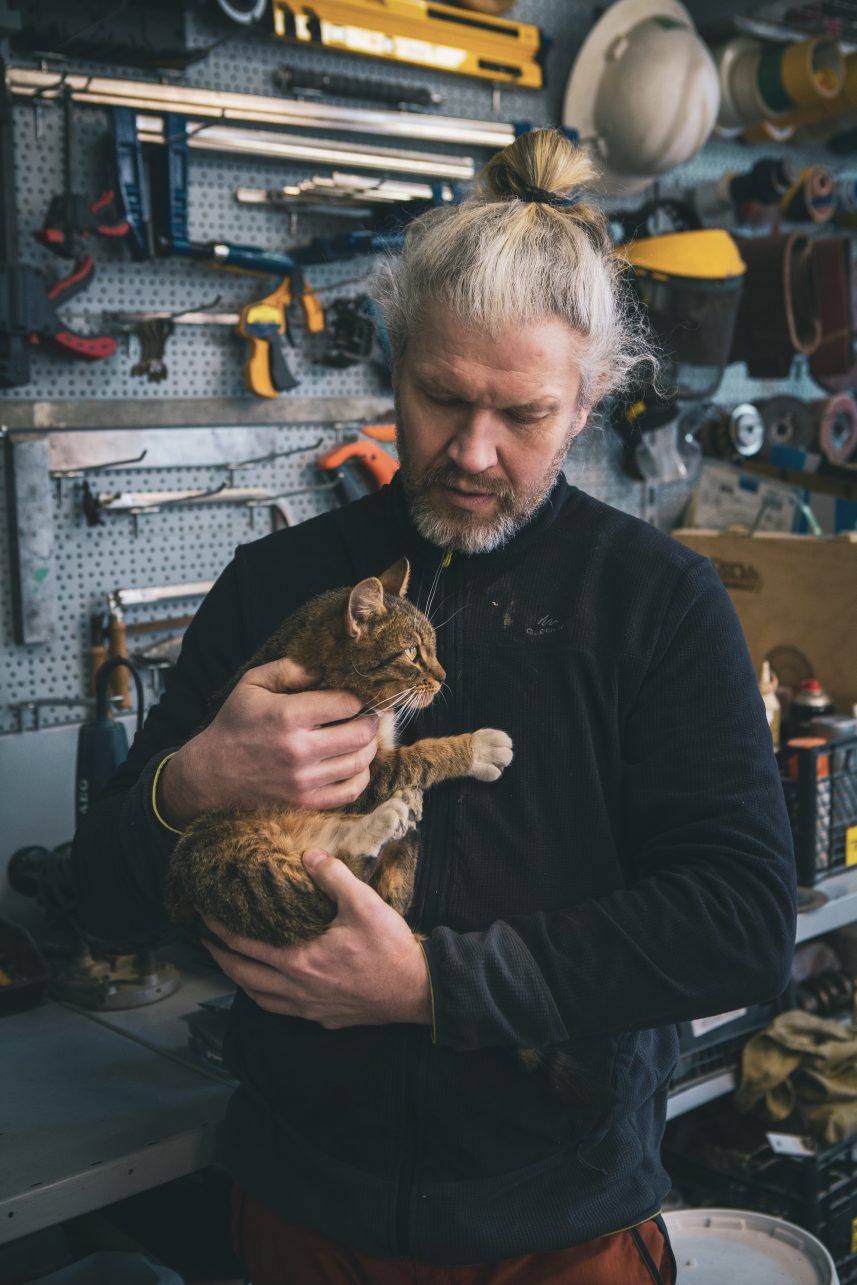
So, if I want to renovate a chair or a lamp, can I just take it and come without registering first or bringing a wallet? “It is better to call in advance,” Giedrius advises and reminds us that no one works in the creative house every day from morning till evening, so arranging a specific time will be easier for everyone. You can come after work or on the weekend. There are no specific fees for the use of the workshop, people donate as much as they can.
Next to the workshop space, there will be a separate room for handicraft workshops and parties, where a 4-meter table designed by Giedrius has already found its place. Water supply, sewerage and sanitary facilities are also being installed. On the second floor, accommodation for pilgrims is planned as well as space for children’s daycare center, environmentally friendly children’s birthdays, and the two adjoining rooms will be dedicated for those, who want to stay here longer.
Looking out the windows, the gaze turns to the courtyard, which has not been forgotten also. It is planned to install a gazebo and communal beds for growing vegetables and herbs. You will definitely be able to taste them during events. It is planned to assign several beds to the neighboring kindergarten. In addition to repairs, the range of events is constantly being supplemented: film and digital film screenings, theatre performances, sutartinės singing classes, discussion series about a sustainable, minimalist lifestyle. Are you looking for a place for your exhibition and event? Giedrius and his team invite you to take advantage of this space.
The ideas of sustainability, environmental protection, responsible and sustainable consumption have long been a part of Giedrius’ philosophy, lifestyle and a source of livelihood. That is why it became a leitmotif uniting the work of this Kaunas resident and K.I.N.A.S. Panemunė activities and one of the axes around which the activities of the creative house will revolve.
“This long road started with objects and design. The change was inspired by the trash design works of professional designers in Finland. I was surprised that Finns, who have a lot of money, create design objects from secondary raw materials and rubbish. After the initial impulse to change the world, the change actually came gradually rather than radically. This is how the social initiative Creative Angle 360 °, a hiking trip for Clean Lithuania! and ideas in Pramonės district came about, which later moved to this place.
The events at K.I.N.A.S. Panemunė take place without single-use plates and utensils, balloons, firecrackers, alcohol and are always organized in a minimalist spirit. We strive to promote this and show how we can celebrate in harmony with the environment. At first, I wanted to change the world, but I realized I needed to change myself first. Then there are people who come to the workshop and are interested in the activity and that is how the environment changes.” I asked Giedrius what the best way is to start changing. “We can employ the big ego to save ourselves from polluted environment, air, water and food and by saving ourselves we will also save the environment. All of that is an important cycle.”
The easiest way to start your own sustainable cycle of change is by visiting K.I.N.A.S. Panemunė. The place is accessible by car and on foot at Vaidoto St. 26. You can also reach it by trolleybus no.1 and 4 and busses no. 27G, 46, 47, and 68 (bus stop: KTU inžinerijos licėjus).

